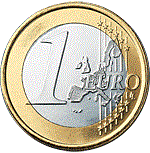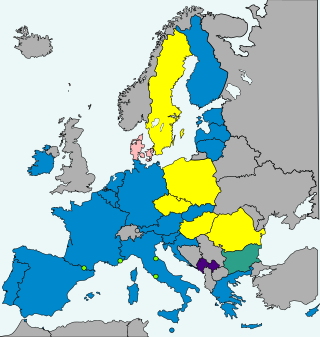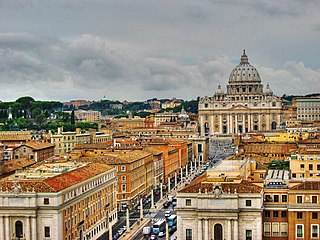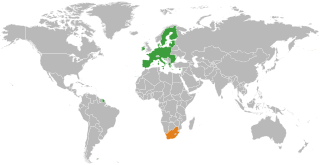
There are eight euro coin denominations, ranging from one cent to two euros. The coins first came into use in 2002. They have a common reverse, portraying a map of Europe, but each country in the eurozone has its own design on the obverse, which means that each coin has a variety of different designs in circulation at once. Four European microstates that are not members of the European Union use the euro as their currency and also have the right to mint coins with their own designs on the obverse side.
Christianity is the largest religion in Belgium, with the Catholic Church representing the largest community, though it has experienced a significant decline since the 1950s. Belgium's policy separates the state from the churches, and freedom of religion of the citizens is guaranteed by the country's constitution.

The Czech Republic is bound to adopt the euro in the future and to join the eurozone once it has satisfied the euro convergence criteria by the Treaty of Accession since it joined the European Union (EU) in 2004. The Czech Republic is therefore a candidate for the enlargement of the eurozone and it uses the Czech koruna as its currency, regulated by the Czech National Bank, a member of the European System of Central Banks, and does not participate in European Exchange Rate Mechanism II.

Poland does not use the euro as its currency. However, under the terms of their Treaty of Accession with the European Union, all new Member States "shall participate in the Economic and Monetary Union from the date of accession as a Member State with a derogation", which means that Poland is obliged to eventually replace its currency, the złoty, with the euro.

The Slovenian Catholic Church, or Catholic Church in Slovenia is part of the worldwide Catholic Church, under the spiritual leadership of the Pope in Rome. The 2018 Eurobarometer data shows 73.4% of Slovenian population identifying as Catholic that fell to 72.1% in the 2019 Eurobarometer survey. According to the Catholic Church data, the Catholic population fell from 78.04% in 2009 to 72.11% in 2019.

Christianity is the largest religion in Luxembourg, with significant minorities of non-religious people and adherents of other faiths.

Romania's national currency is the leu. After Romania joined the European Union (EU) in 2007, the country became required to replace the leu with the euro once it meets all four euro convergence criteria, as stated in article 140 of the Treaty on the Functioning of the European Union. As of 2023, the only currency on the market is the leu and the euro is not yet used in shops. The Romanian leu is not part of the European Exchange Rate Mechanism, although Romanian authorities are working to prepare the changeover to the euro. To achieve the currency changeover, Romania must undergo at least two years of stability within the limits of the convergence criteria.
Accurate demographics of atheism are difficult to obtain since conceptions of atheism vary considerably across different cultures and languages, ranging from an active concept to being unimportant or not developed. Also in some countries and regions atheism carries a strong stigma, making it harder to count atheists in these countries. In global studies, the number of people without a religion is usually higher than the number of people without a belief in a deity and the number of people who agree with statements on lacking a belief in a deity is usually higher than the number of people who self-identify as "atheists".

Christianity in Italy has been historically characterised by the dominance of the Catholic Church since the East–West Schism. However, the country is also home to significant Christian minorities, especially Orthodox Christians, Protestants and Jehovah's Witnesses.

Religion in the European Union is diverse. The largest religion in the EU is Christianity, which accounted for 72.8% of EU population as of 2018. Smaller groups include those of Islam, Buddhism, Judaism, Hinduism, and some East Asian religions, most concentrated in Germany and France. Also present are revival movements of pre-Christianity European folk religions including Heathenism, Rodnovery, Romuva, and Druidry.
Hungary has recognized registered partnerships since 1 July 2009, offering same-sex couples nearly all the rights and benefits of marriage. Unregistered cohabitation for same-sex couples was recognised and placed on equal footing with the unregistered cohabitation of different-sex couples in 1996. However, same-sex marriage is prohibited by the 2011 Constitution of Hungary, which took effect in January 2012.
The Young Europeans Reports is a series of representative surveys of young Europeans (15-24) conducted on behalf of the European Commission, and is part of the Eurobarometer. While the first survey, conducted in 1982, covered only ten countries, the second and third included 12 members of the EU, and fourth included 15 EU countries: Belgium, Denmark, Finland, Germany, Greece, Ireland, Spain, France, Italy, Luxembourg, The Netherlands, Austria, Portugal, and Sweden, and the United Kingdom. The surveys repeat many of the same questions, thus allowing comparison over time. They are each carried out in conjunction with the large and more general Eurobarometer surveys, thus allowing comparison between the young population and general population.
Irreligion in Belgium pertains to citizens of Belgium that are atheist, agnostic, or otherwise unaffiliated with any religion. Irreligion is the second most common religious stance in Belgium, following Catholicism.

The European Union (EU) has strong cultural and historical links to South Africa and the EU is South Africa's biggest investor.

Corruption in Lithuania describes the prevention and occurrence of corruption in Lithuania.

Corruption in Slovenia is examined on this page.
The Arab Barometer is a nonpartisan research network that provides insight into the social, political, and economic attitudes and values of ordinary citizens across the Arab world. It has been conducting public opinion surveys in the Middle East and North Africa (MENA) since 2006. It is the largest repository of publicly available data on the views of men and women in the MENA region. The project has conducted more than 70,000 interviews over five waves of surveys across 15 countries in MENA since 2006. The project is organized through a partnership between Princeton University, the University of Michigan, and regional partners across the Middle East and North Africa. The project is governed by a Steering Committee including academics and researchers from MENA and the United States.
This article details the geographical distribution of speakers of the Italian language, regardless of the legislative status within the countries where it is spoken. In addition to the Italian-speaking area in Europe, Italian-speaking minorities are present in few countries.
Dutch speakers, or Batavophones, are globally concentrated in the Netherlands, Belgium, and Suriname. Dutch is also spoken in minority areas through Europe and in many immigrant communities in all over the world. Afrikaans is a daughter language of Dutch, but is regarded as a separate language and will not be analyzed in this article.








